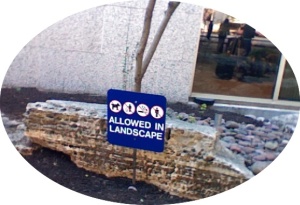by Jane Anne Morris
 How is it unconstitutional for a state to require place-of-origin labels on meat? Regulate sale of its water? Establish worker protections stricter than federal standards? Where does the US Constitution say that states cannot require that toxic waste be sorted and labeled? Cannot include labor standards in state purchasing policy? Cannot make companies disclose what chemicals they use in products and facilities?1
How is it unconstitutional for a state to require place-of-origin labels on meat? Regulate sale of its water? Establish worker protections stricter than federal standards? Where does the US Constitution say that states cannot require that toxic waste be sorted and labeled? Cannot include labor standards in state purchasing policy? Cannot make companies disclose what chemicals they use in products and facilities?1
The Constitution is silent on these matters, but the Supreme Court has interpreted the Constitution all the way to next Tuesday in order to declare these measures unconstitutional. Supreme Court interpretation devised concepts like free speech rights for corporations, and that workhorse, money equals speech, to hobble election reform. Judicial interpretation enables corporations to use the Civil Rights Act to claim damages for being “discriminated” against. Supreme Court interpretation dished out rights, powers, and protections for corporations while repeatedly denying same to minorities, women, and workers.
Constitutional scholars routinely describe the Court as the most powerful court in the history of the world.2 In addition to its untrammeled interpretive latitude, that singular institution wields a bundle of powers. It decides cases, rules on the constitutionality of acts of the executive branch, determines the distribution of powers between state and federal government, and judges the constitutionality of any law passed at any level of government. It can “call up” any court’s ruling if it disagrees. Justices scan the nation’s laws, and using easily rigged “test” cases, void any law not to their liking.
This power does not come from the Constitution, which, apart from a few matters (like ambassadors and Indian tribes), specifies very little about the Supreme Court.3 The vast powers and maxed-out discretion exercised by the Court come from the US Congress. A series of Judiciary Acts (1790, 1875, 1925, and 1988) sketch (and stretch) the dimensions of its power.
So if you are concerned that corporations have most of the constitutional rights of human persons, or that numerous “green” state and local laws are thrown out as unconstitutional, then the true object of your discontent is neither the Constitution, nor the Supreme Court, but Congress.
Congress could borrow from other countries’ systems that not only tolerate less poetic license in judicial interpretation, but spread around what the current Supreme Court concentrates into one big-box power center. Special constitutional courts rule on the constitutionality of laws. A separate court decides cases between parties. Yet another court handles human rights violations, and by “human,” they mean, uh, human, and not corporate persons. Sometimes, legislative bodies can overrule court decisions.
Within the US, state legislatures and members of Congress have offered correctives to the existing “Godzilla” Supreme Court. Such as, requiring a supermajority or unanimity of Supreme Court Justices to declare a law unconstitutional; allowing Congress (or another legislative body) to overrule a decision on constitutionality; and removing the Congress-granted power of the Court to second-guess state courts on constitutional questions. A national referendum has also been suggested.
Congress need not retain two centuries of Congressional Acts uploading legislative powers into the judicial bailiwick. Perhaps Congress likes it this way, confident that any serious and effective reforms will be declared unconstitutional by the “branch” next door.
The ball is in our court, the people’s court: the US Congress.
Corporate anthropologist Jane Anne Morris’s Gaveling Down the Rabble is cited in an amicus brief filed in Citizens United v. FEC (the “Hillary film” corporate speech case). Morris is currently writing a book about the Supreme Court.
This article first appeared in Justice Rising (Alliance for Democracy), ed. Jim Tarbell. Spring 2010, Vol. 4, #4.
- Many of these instances are discussed in Gaveling Down the Rabble: How “Free Trade is Stealing Our Democracy.
- “This awesome power” (Peter Irons, A People’s History of the Supreme Court, NY: Penguin Putnam, 1999, p. 40.); “The most powerful court the world has ever known” (Ronald D. Rotunda and John E. Nowak, Treatise on Constitutional Law, St. Paul, Minn.: West Group, 1999, p. 3); “The world’s most powerful court” (Felix Frankfurter, “Mr. Justice Brandeis and the Constitution,” pp. 47-125 in Felix Frankfurter, ed., Mr. Justice Brandeis, New Haven: Yale Univ. Press, 1932, p. 125); Power “unique in judicial history” according to Archibald Cox (Solicitor General under President Kennedy and Watergate Special Prosecutor). Also, “No other country has given its courts such extraordinary power.” (Archibald Cox, The Court and the Constitution, Boston: Houghton Mifflin Co., 1987, pp. 44-45); Sup. Ct. power to strike down laws is “the most expansive application of any people in the world” (Dudley O. McGovney, “The British Origin of Judicial Review of Legislation,” 93 Univ. of Penn. Law Rev., 1, (1944), pp. 1-49, p. 1).
- The U.S. Constitution says only this (Art. III. Sec. 1): The judicial power of the United States, shall be vested in one Supreme Court, and in such inferior courts as the Congress may from time to time ordain and establish.